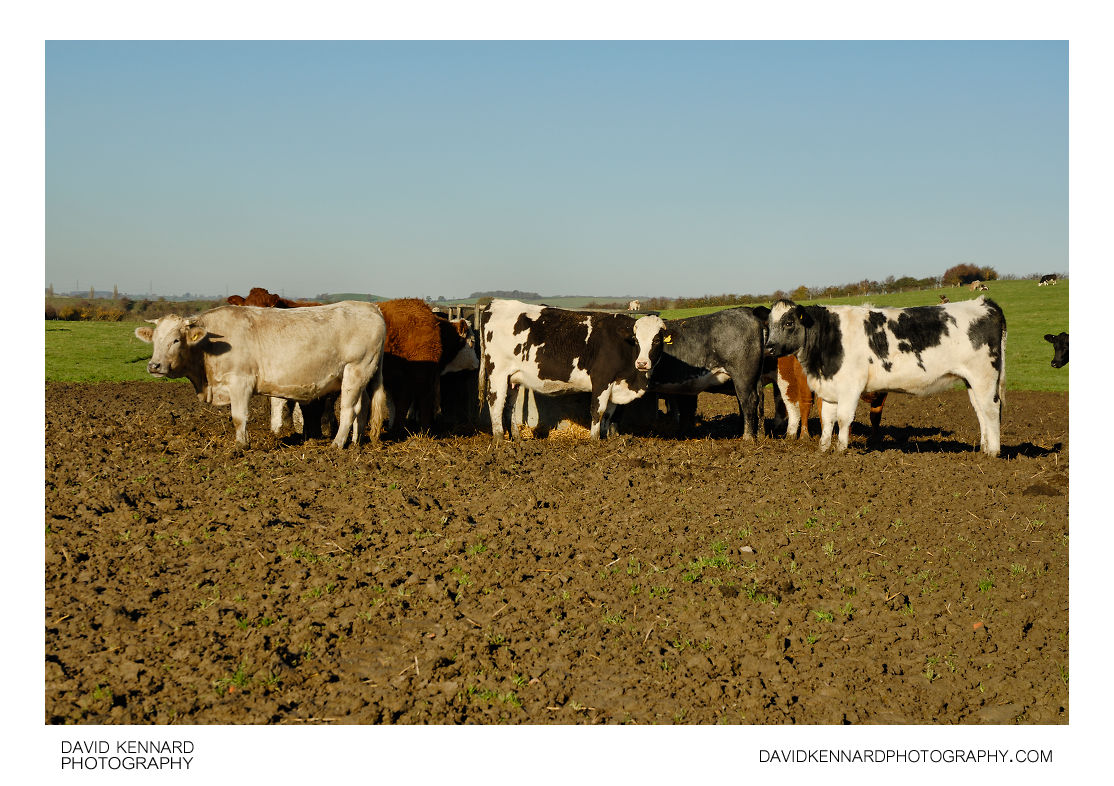Cattle in mud

Description
- Title:
- Cattle in mud
- Caption / Description:
-
Cattle gather round a feeding trough in a field to the west of Medbourne, in Leicestershire, UK.
From Wikipedia (http://en.wikipedia.org/wiki/Cattle):
Cattle (colloquially cows) are the most common type of large domesticated ungulates. They are a prominent modern member of the subfamily Bovinae, are the most widespread species of the genus Bos, and are most commonly classified collectively as Bos primigenius. Cattle are raised as livestock for meat (beef and veal), as dairy animals for milk and other dairy products, and as draft animals (pulling carts, plows and the like). Other products include leather and dung for manure or fuel.
Cattle occupy a unique role in human history, domesticated since at least the early Neolithic. They are raised for meat (beef cattle), dairy products and hides. They are also used as draft animals and in certain sports. Some consider cattle the oldest form of wealth, and cattle raiding consequently one of the earliest forms of theft.
Cattle are often raised by allowing herds to graze on the grasses of large tracts of rangeland. Raising cattle in this manner allows the use of land that might be unsuitable for growing crops. The most common interactions with cattle involve daily feeding, cleaning and milking. Many routine husbandry practices involve ear tagging, dehorning, loading, medical operations, vaccinations and hoof care, as well as training for agricultural shows and preparations. There are also some cultural differences in working with cattle- the cattle husbandry of Fulani men rests on behavioural techniques, whereas in Europe cattle are controlled primarily by physical means like fences. Breeders use cattle husbandry to reduce M. bovis infection susceptibility by selective breeding and maintaining herd health to avoid concurrent disease.
- Tags / Keywords:
-
- Europe
- UK
- Britain
- England
- East Midlands
- Leicestershire
- Field
- Biota
- Life
- Vitae
- Eukaryota
- Animalia
- Animals
- Chordata
- Chordates
- Artiodactyla
- Cloven-hoofed ungulates
- Mammalia
- Mammals
- Mud
- Bovidae
- Cattle
- Cows
- Bovinae
- Bos
- Bos primigenius
- Medbourne
Admin
- Date Original Photo Taken:
- Original File Name:
- _DSC2751a.psd
- Event:
- Rating:
- ☆
- Date this image added/last updated on website:
- Original File Dimensions:
- 3785px x 2533px
- File Type:
- JPEG
- Color Mode:
- RGB
- Original Image Color Profile:
- Nikon Adobe RGB 4.0.0.3000
Location
- Location Shown:
-
- Sublocation:
- City:
- Medbourne
- Province/State:
- Leicestershire
- Country:
- United Kingdom
- World Region:
- Europe
- Location Created:
-
- Sublocation:
- City:
- Medbourne
- Province/State:
- Leicestershire
- Country:
- United Kingdom
- World Region:
- Europe
- Geo-location:
- 52.526923199917, -0.838567 View on map
Rights
- Copyright Status:
- Copyrighted
- Licensing Status:
- Rights Managed
- Available for Editorial Use:
- Yes
- Available for Commercial Use:
- No
- Copyright Notice:
- © 2010 Dave Kennard
Camera Data
- Date Digital Resource was created:
- Shutter speed:
- 1⁄160 s
- Aperture:
- f/8
- Camera Model:
- Nikon D200
- ISO:
- 100
- Exposure Compensation:
- 0
- Focal Length:
- 50mm
- Focal Length (35mm equiv.):
- 75mm
- Metering Mode:
- Multi-segment
- Flash:
- No Flash
- Exposure Mode:
- Auto
- White Balance:
- Manual
- Light Source:
- Cloudy
- Exposure Program:
- Aperture-priority AE
Additional shooting metadata
- Lens:
- Nikon AF-S DX Zoom Nikkor ED 18-70mm F3.5-4.5G(IF)
- Filters used:
- Additional Optics used:
- Setup:
- Handheld
Post Processing
- Image Modified:
- Software used:
-
- Nikon Capture NX 2
- Adobe Photoshop CS5
- Post Processing:
-0.39 exposure compensation in CNX2
Color Control Point used in CNX2 to brighten and add contrast
Straightened in CNX2
Dust spot removed using auto retouch brush in CNX2
Topaz Adjust 4 with 'Photo Pop' preset applied in PS CS5
